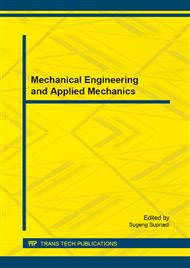p.89
p.95
p.101
p.107
p.113
p.119
p.125
p.131
p.137
Design of Sea Currents Turbine
Abstract:
. Research on sea current energy uses as a sea current electrical power plant (PLTAL) in the region of Lembongan-Nusa Penida-Ceningan carried out since 2013, aiming to meet the demand for electricity in the coastal areas and remote islands. This study aims to design a marine current turbine which is planned to generate electricity of about 50 kW, with a construction system made fixed and the turbine set inside that can spin revolving without interruption. Simulation model of the flow is done by using Computational Fluid Dynamics analysis, CFD. Simulations conducted in private with a variety of flow velocity and pressure of the sea water and various forms of channels. Based on the results obtained by simulation, the best flow of sea currents is with a slope angle of 300 with a channel length of 15 m where the flow speed of the turbine of about 39 m/s with a flow pressure of 201,426 Pa, which predicted to be capable of producing 1,500 kW turbine power.
Info:
Periodical:
Pages:
113-118
Citation:
Online since:
April 2015
Authors:
Keywords:
Price:
Сopyright:
© 2015 Trans Tech Publications Ltd. All Rights Reserved
Share:
Citation:


